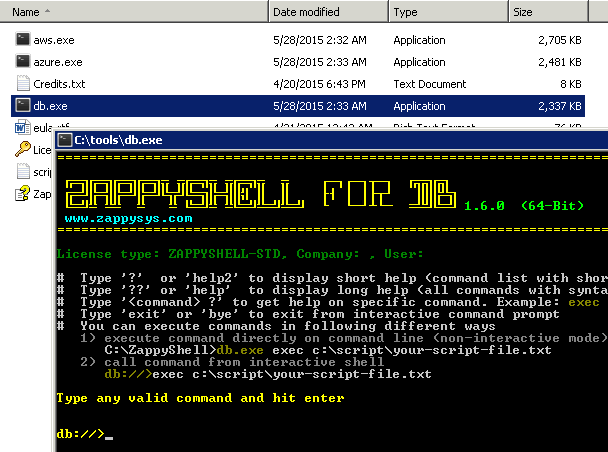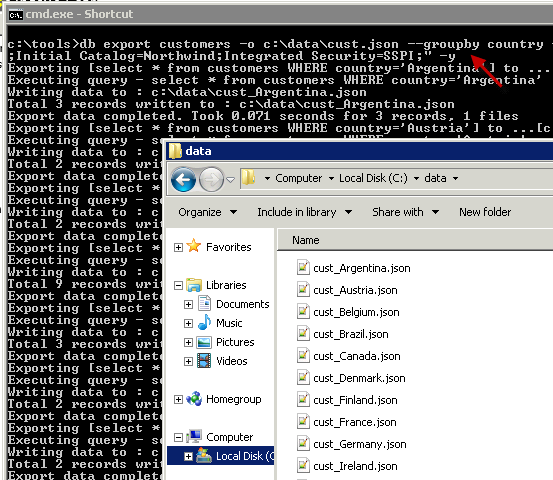Introduction
JSON File format is becoming very popular due to its simplicity and smaller size. Most of NoSQL Databases are now using JSON for their document mechanism. In this article we will learn how to use various techniques to generate JSON data files from SQL Server Table or any other relational source such as MySQL or Oracle. This article is mainly focused on exporting data from Microsoft SQL Server to JSON but you can use same tools/techniques to export from any RDBMS (As long as you have correct drivers installed.).
The problem
Solution
Export SQL Server data to JSON using SSIS PowerPack
Export SQL Server data to JSON using ZappyShell Command line

ZappyShell Command Line Tools – Export JSON, Excel, CSV, PDF
SQL Server JSON Export – Single table
c:\tools>db.exe export customers --out c:\data\customers..json --json --overwrite --connstr "Data Source=localhost;Initial Catalog=Northwind;Integrated Security=SSPI;"SQL Server JSON Export – Multiple tables
c:\tools>db.exe export customers|orders|products --out c:\data\customers..json --json --overwrite --connstr "Data Source=localhost;Initial Catalog=Northwind;Integrated Security=SSPI;"SQL Server JSON Export – Multiple tables (using pattern)
c:\tools>db.exe export cust% --schema Sales --out c:\data\customers..json --json --overwrite --connstr "Data Source=localhost;Initial Catalog=Northwind;Integrated Security=SSPI;"SQL Server JSON Export – SQL Query
c:\tools>db.exe export "select * from customers where country like 'US%'" --out c:\data\customers.json --json --overwrite --connstr "Data Source=localhost;Initial Catalog=Northwind;Integrated Security=SSPI;"Using Map File for nested SQL Server JSON Export
Lets say you want to export customer data along with orders they placed as nested JSON document then we have to supply Map file so JSON Generator can figure out how to JOIN two datasets and how to Shape JSON. In below example we are doing 3 nested levels for demo purpose. Customer joined with Orders by CustomerID key, Orders Joined with Employee by EmployeeID key.
MySampleMap.xml
<?xml version="1.0" encoding="UTF-8"?>
<settings ver="1">
<dataset id="cust" main="true">select * from Customers</dataset>
<dataset id="ord">select * from Orders</dataset>
<dataset id="emp">select * from Employees</dataset>
<join parentid="cust" childid="ord" keys="CustomerID" />
<join parentid="ord" childid="emp" keys="EmployeeID" />
<map src="CustomerID" name="ID" />
<map src="CompanyName" />
<map name="Contact">
<map src="Phone" />
<map src="Fax" />
<map name="Location">
<map src="Country" />
<map src="Region" />
</map>
</map>
<map name="OrderIDList" dataset="ord" maptype="valuearray" src="OrderID"/>
<map name="Orders" dataset="ord">
<map src="OrderID" />
<map src="OrderDate" />
<map name="EmpInfo" dataset="emp">
<map src="EmployeeID" />
<map src="FirstName" />
</map>
</map>
</settings>
c:\tools>db.exe export --map c:\MySampleMap.xml --out c:\data\customers.json --connstr "Data Source=localhost;Initial Catalog=Northwind;Integrated Security=SSPI;"
customers.json : Output JSON generated from above Command
[
{
"ID": "ALFKI",
"CompanyName": "Alfreds Futterkiste",
"Contact": {
"Phone": "030-0074321",
"Fax": "030-0076545",
"Location": {
"Country": "Germany",
"Region": null
}
},
"OrderIDList": [10643,10692],
"Orders": [
{
"OrderID": 10643,
"OrderDate": "1997-08-25",
"EmpInfo": [
{
"EmployeeID": 6,
"FirstName": "Michael"
}
]
},
{
"OrderID": 10702,
"OrderDate": "1997-10-13",
"EmpInfo": [
{
"EmployeeID": 4,
"FirstName": "Margaret"
}
]
}
]
},
{
"ID": "ANATR",
"CompanyName": "Ana Trujillo Emparedados y helados",
"Contact": {
"Phone": "(5) 555-4729",
"Fax": "(5) 555-3745",
"Location": {
"Country": "Mexico",
"Region": null
}
},
"OrderIDList": [10308,10625,10759,10926],
"Orders": [
{
"OrderID": 10308,
"OrderDate": "1996-09-18",
"EmpInfo": [
{
"EmployeeID": 7,
"FirstName": "Robert"
}
]
},
{
"OrderID": 10625,
"OrderDate": "1997-08-08",
"EmpInfo": [
{
"EmployeeID": 3,
"FirstName": "Janet"
}
]
}
]
}
]
SQL Server JSON Export – Split Files
Sometimes you may have need to split large amount of data into multiple files. With ZappyShell command line you can split data three different ways. Lets check each example.
SQL Server JSON Export – Split By Row Count
In below example we are exporting SQL Server customer table to JSON files and splitting files with maximum 1000 records per file option.
c:\tools>db.exe export customers --out c:\data\cust.json --split --splitrows 1000 --connstr "Data Source=localhost;Initial Catalog=Northwind;Integrated Security=SSPI;"
SQL Server JSON Export – Split Files By File Size
In below example we are exporting SQL Server customer table to JSON files and splitting files with maximum file size = 10MB option. You also use other size specifier like KB, GB, BYTES etc.
c:\tools>db.exe export customers --out c:\data\cust.json --split --splitsize 10MB --connstr "Data Source=localhost;Initial Catalog=Northwind;Integrated Security=SSPI;"
SQL Server JSON Export – Split Files By Group By Column
In this example we have exported customers in to separate file by country.
c:\tools>db.exe export customers --out c:\data\cust.json --groupby Country --connstr "Data Source=localhost;Initial Catalog=Northwind;Integrated Security=SSPI;"

ZappyShell – Export SQL Server Table to JSON, Split files by Country Column
SQL Server JSON Export – Compressed files
If you want to output compressed JSON (GZIP format) then use below command.
c:\tools>db.exe export customers --out c:\data\cust.json --gzip --connstr "Data Source=localhost;Initial Catalog=Northwind;Integrated Security=SSPI;"
Using date time place holders in JSON file name
If you want to use date time place holders in file name so it automatically uses specified date time parts use below command simply putting specifiers in file name anywhere.
c:\tools>db.exe export customers --out c:\data\cust_{{YYYY}}_{{MM}}_{{DD}}_{{HH24}}_{{MI}}_{{SS}}.json --connstr "Data Source=localhost;Initial Catalog=Northwind;Integrated Security=SSPI;"
SQL Server JSON Export – Multi Content format
c:\tools>db.exe export customers --out c:\data\cust.json --json-multi-content --connstr "Data Source=localhost;Initial Catalog=Northwind;Integrated Security=SSPI;"
